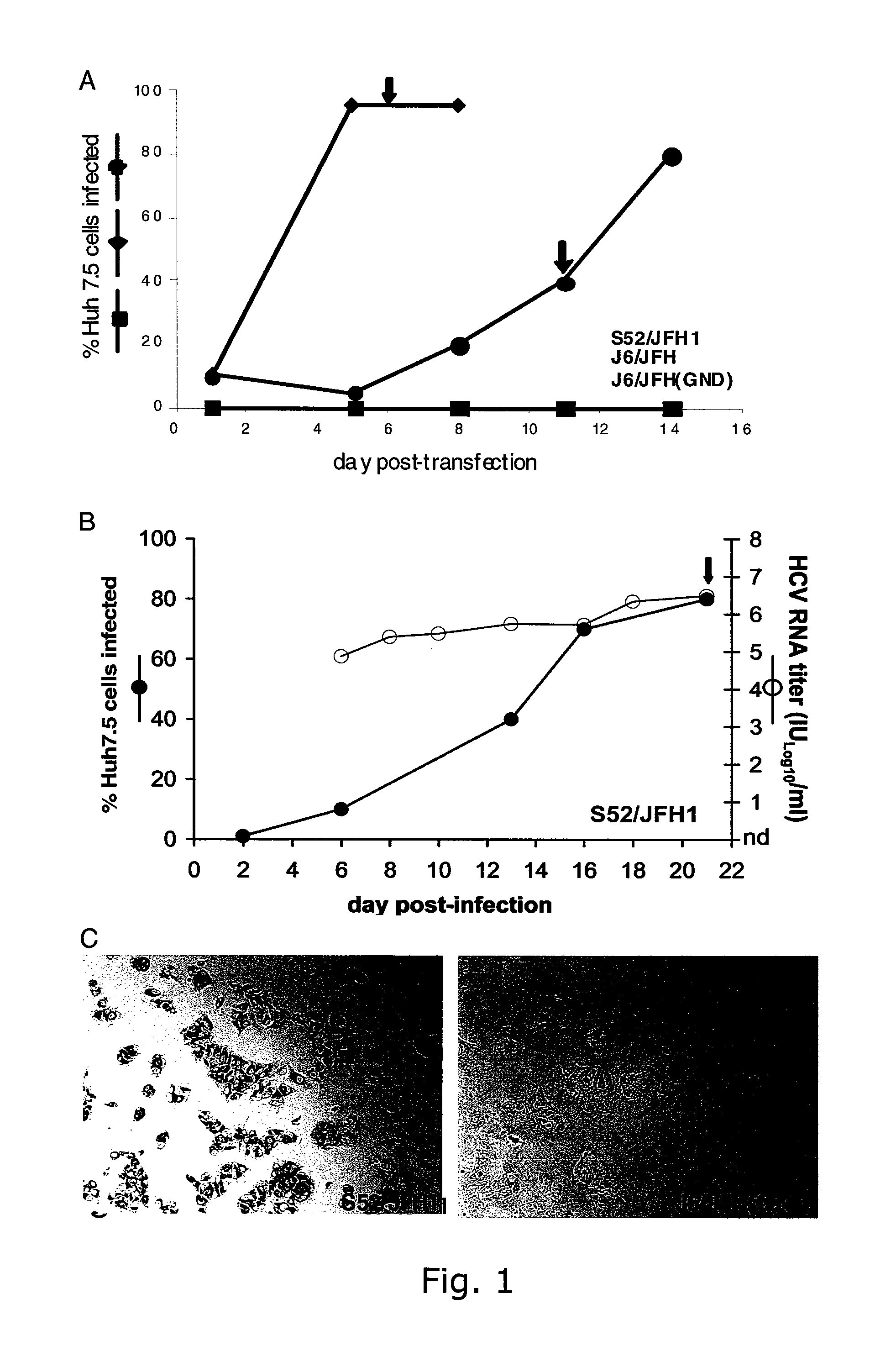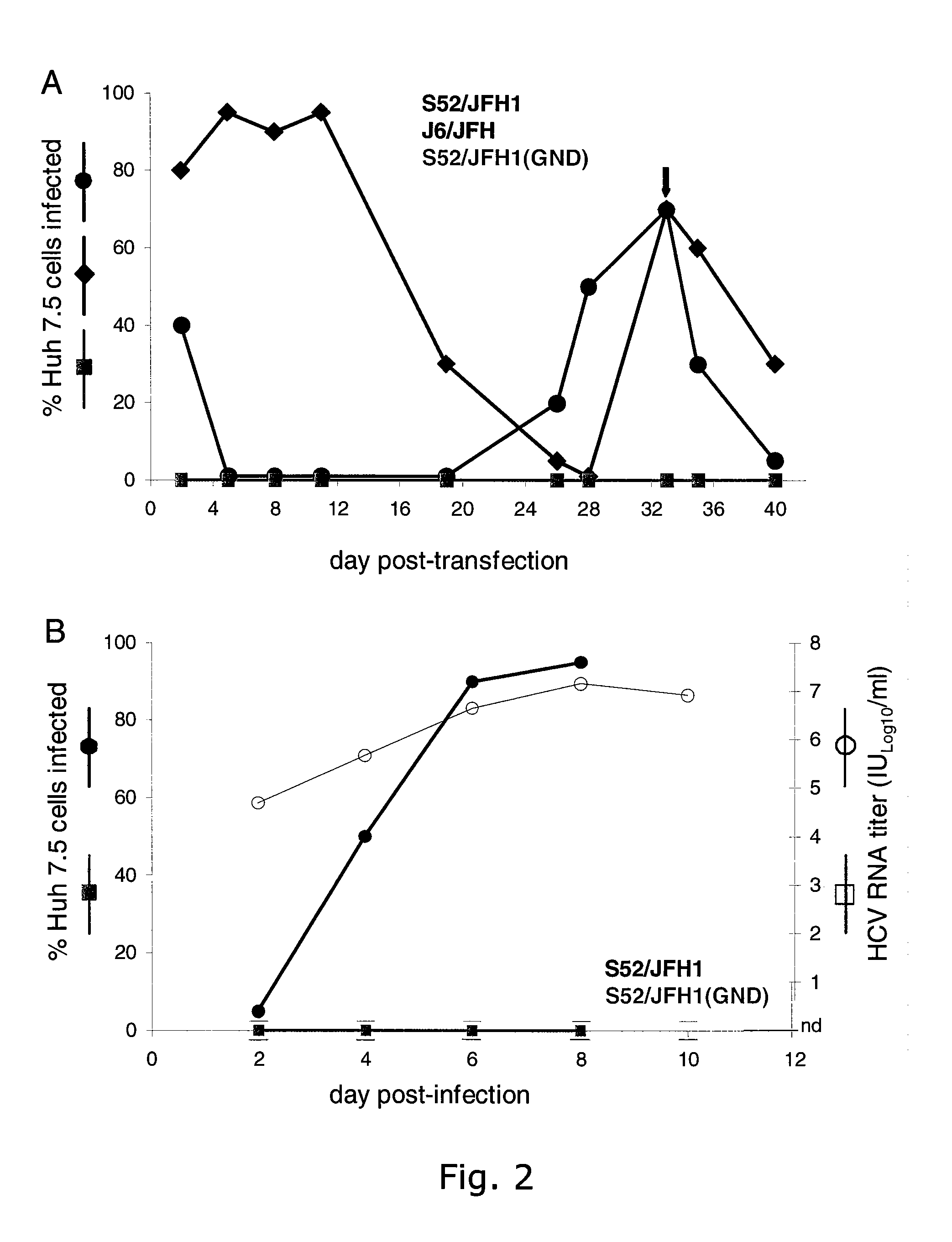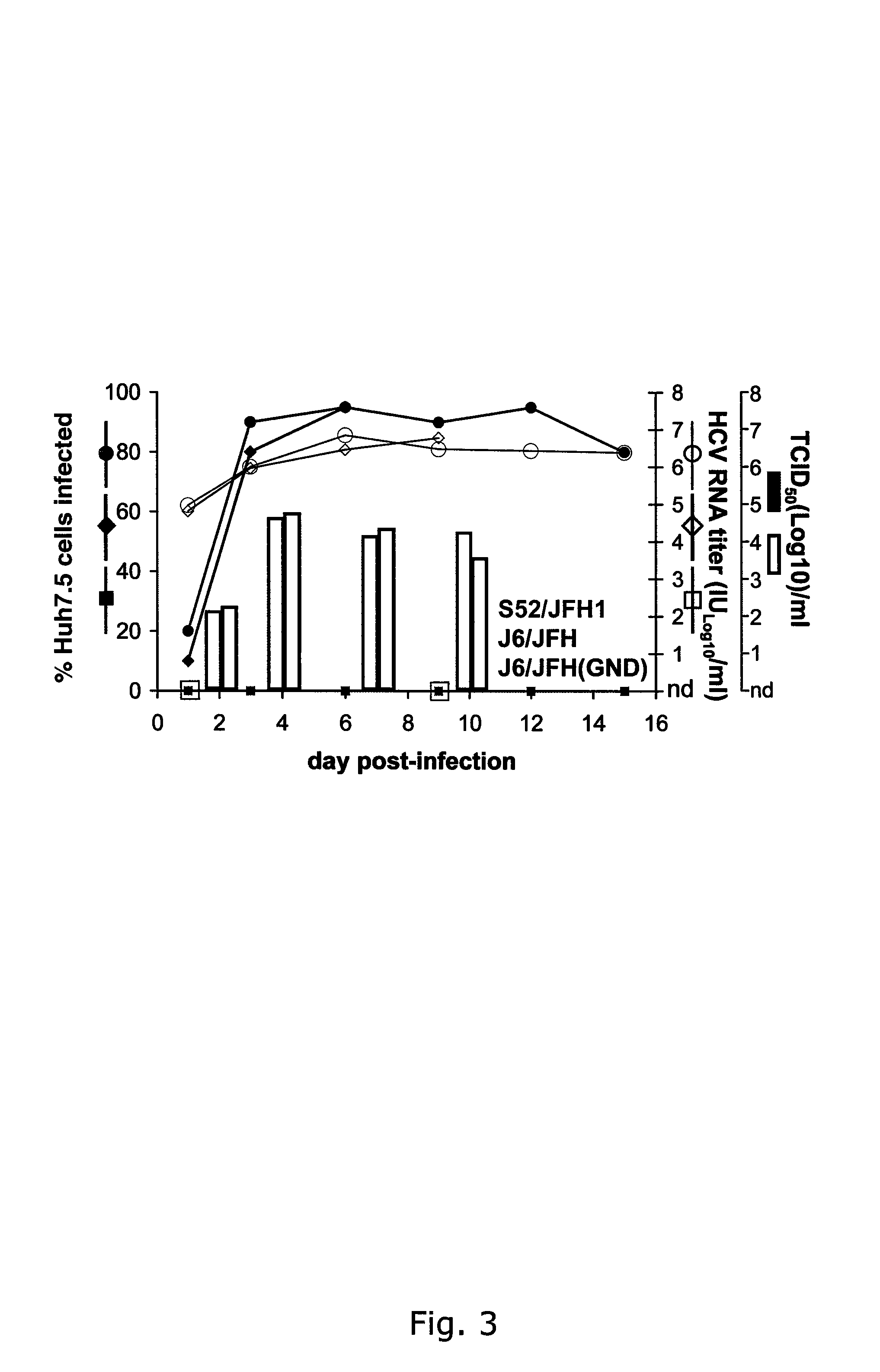Cell culture system of a hepatitis C genotype 3a and 2a chimera
a cell culture system and chimera technology, applied in the field of infectious recombinant hepatitis c viruses, can solve the problems of increased risk of liver cirrhosis, hepatocellular carcinoma, combination therapy with interferon and ribavirin, and high cost of hcv therapy, so as to achieve efficient and sustainable growth and improve the effect of cirrhosis
- Summary
- Abstract
- Description
- Claims
- Application Information
AI Technical Summary
Benefits of technology
Problems solved by technology
Method used
Image
Examples
example 1
The J6 / JFH Cell Culture System Yields High Viral Titers and Does Not Require Adaptive Mutations
[0252]The intragenotypic 2a / 2a recombinant J6 / JFH, in which the structural genes (Core, E1 and E2), p7 and NS2 of JFH1 were replaced by the corresponding sequence of the infectious clone pJ6CF, produced infectious viral particles in the human hepatoma cell line Huh7.5. In our hands, transfection of J6 / JFH RNA transcripts into Huh7.5 cells resulted in infection of most cells within 5 days as determined by NS5A immuno-staining (FIG. 1A), and J6 / JFH virus from supernatant collected on day 6 readily infected naive Huh7.5 cells (data not shown). In supernatant from day 8 of this 1st passage the present inventors recorded an HCV infectivity titer of 104.6 TCID50 / ml and an HCV RNA titer of 107.2 IU / ml with a specific infectivity (infectious dose per genomes measured in IU) of 1:398 (TABLE 4). These results are comparable to those obtained by Lindenbach et al. The present inventors demonstrated th...
example 2
[0254]The intergenotypic 3a / 2a recombinant S52 / JFH1 is viable in Huh7.5 cells. To generate pS52 / JFH1, the present inventors first determined the consensus sequence of Core through NS2 of HCV strain S52 (genotype 3a) by amplifying two overlapping fragments from the chimpanzee challenge pool (see Material and Methods), subcloning and analyses of 5 clones of each fragment. The final S52 / JFH1 clone contains Core, E1, E2, p7 and NS2 genes of S52, and the 5′ and 3′ UTR, as well as the NS3, NS4A, NS4B, NS5A, and NS5B genes of JFH1. Compared to the S52 consensus sequence, pS52 / JFH1 contains only noncoding nucleotide changes, which are present at 10 of 3096 (0.3%) nucleotide positions: A641G, A916T (introduced to eliminate an XbaI site), G1039A, C1490T, G1577A, C1709T, G1912A, C2639T, C2792T, C3053T (corresponding to H77 reference genome).
[0255]The delayed viral spread of S52 / JFH1 compared to J6 / JFH indicated selection of adaptive mutations. To further characterize the cell culture derived S...
example 3
Similar Growth Kinetics of S52 / JFH1 and J6 / JFH Viruses
[0258]Naïve Huh7.5 cells were inoculated with ˜104 TCID50 of the S52 / JFH13a / 2a (2nd passage virus) and J6 / JFH 2a / 2a (1st passage virus), respectively (TABLE 4), and in both cultures >90% of cells became infected after 6 days (FIG. 3).
[0259]Furthermore, HCV RNA titers and infectivity titers of S52 / JFH1 and J6 / JFH were similar at all time points analyzed. HCV RNA titers peaked at close to 107 copies / ml at day 6 and 9 and peak infectivity titers were detected on day 3 (104.6 TCID50 / ml for S52 / JFH1 and 104.7 TCID50 / ml for J6 / JFH) (TABLE 4). When comparing specific infectivity, the present inventors recorded the highest values on day 3 post-infection (1:25 for S52 / JFH1 and 1:20 for J6 / JFH) and the lowest values on day 1 post-infection (1:794 for S52 / JFH1 and 1:398 for J6 / JFH). Growth kinetics of S52 / JFH1 and J6 / JFH viruses after infection with ˜103 TCID50 of the respective viruses were also comparable (data not shown).
[0260]The kineti...
PUM
| Property | Measurement | Unit |
|---|---|---|
| temperature | aaaaa | aaaaa |
| volume | aaaaa | aaaaa |
| volume | aaaaa | aaaaa |
Abstract
Description
Claims
Application Information
 Login to View More
Login to View More - R&D
- Intellectual Property
- Life Sciences
- Materials
- Tech Scout
- Unparalleled Data Quality
- Higher Quality Content
- 60% Fewer Hallucinations
Browse by: Latest US Patents, China's latest patents, Technical Efficacy Thesaurus, Application Domain, Technology Topic, Popular Technical Reports.
© 2025 PatSnap. All rights reserved.Legal|Privacy policy|Modern Slavery Act Transparency Statement|Sitemap|About US| Contact US: help@patsnap.com



